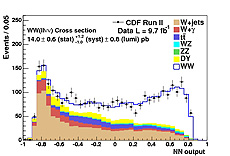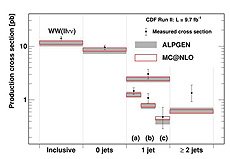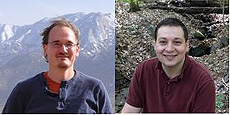Studying double W's at the Tevatron
 |
| Estimated and observed distribution for our algorithm, which
is used to identify WW events. High values of NN indicate a more signal-like event. |
In a recent measurement, the CDF experiment studied in detail events with two massive W vector bosons produced with associated jets (a spray of particles resulting from an energetic quark or gluon). These types of events are widely considered to be a window for looking for physics beyond the Standard Model.
Each W can decay into a charged lepton (an electron or a muon) and a neutrino, which has no charge. So to identify the production of W pairs, we look for two leptons (one from each W) with high momentum transverse to the beam and missing transverse energy (accounted for by the neutrinos). We also have to rule out the dominant backgrounds, the three main sources of which are top quark pair production, Z decay into leptons with mismeasured transverse energy and single W production with a misidentified second lepton.
This measurement is made possible by the relatively low energy of the Tevatron, which results in a manageable production rate for pairs of top quarks, the dominant background for events with two W bosons and two or more jets. This analysis measures for the first time the rate of production of W boson pairs as a function of the energy and multiplicity of associated jets.
Events are classified by the number of jets and transverse energy. Those with two or more jets are vetoed if they are found to contain a bottom quark, which is typical of top quark decay, one of our background culprits.
Advanced mathematical techniques called neural networks exploit features of the signal and background to further distinguish signal events while preserving efficiency.
The upper figure shows a result of a fit to the WW signal and the expected backgrounds. The results as a function of the number of jets are found to be consistent with the Standard Model prediction, as shown in the lower figure.
The CDF study demonstrates for the first time the validity of commonly used simulation techniques to model events with multiple vector bosons and additional jets. The result can also be directly compared to new simulation techniques, essential to searches for physics in the coming LHC run and beyond. If new physics is not directly observed in the upcoming second LHC run, evidence could appear indirectly in the scattering of massive vector bosons such as the W. An analysis like this one could be performed at the LHC and result in a much larger yield of events than predicted by the Standard Model. It would be a very difficult measurement because of large backgrounds at a high-luminosity 13-TeV LHC.
Nevertheless, such a measurement could be a handle on new physics, perhaps extra-dimensional models, new gauge bosons or new Higgs models.
—Will Parker and Andy Beretvas
Learn more
 |
| Measurement and predictions (ALPGEN and MCF@NLO) for σ(pp → W+W- + njets). The one jet bin is also subdivided into transverse energy ranges of
(a) 15 < ET < 25, (b) 25 < ET < 45, and (c) ET > 45 GeV. |
 |
| Matt Herndon and Will Parker, both from the University of Wisconsin, are the primary analysts for this result. |
|